Turangi to New Plymouth: Bicycling the Forgotten World Highway

Over the past few weeks, one of the things we heard again and again was that we should make time to ride the Forgotten World Highway Cycle Route. Spanning 180km between Taumarunui and New Plymouth, this route cuts through some of the most remote parts of New Zealand and glimpses back into Kiwi life a century or so ago. After spending the holidays in Taupo and Turangi, we set out through the Forgotten World. Although the route officially begins in Taumarunui, we felt like it began (for us) in Turangi, because that was the first day that traffic levels dropped off and we felt like we were riding through truly rural countryside.
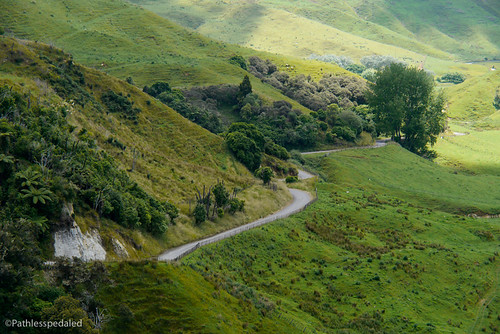
Luckily for us, the day we left Turangi, the sun decided to re-appear after several rainy days. Between the clear weather and the much-reduced travel volumes, it was a lovely day to be back on the road. First we rambled around the southern end of Lake Taupo, then we rambled up, up, up our make our way out of the Taupo basin. It was exhausting work, but the views were stunning. And with all the rain of the several days previous, we were treated to dozens of roadside waterfalls. Eventually, the road dumped us out in Taumurunui, and we stopped at a small cafe for a late lunch before making our way to our camp spot for the night. As we were settling in at the Taumarunui Holiday Park, who should arrive but other bike tourists! A whole family of bike tourists, to be exact. Every summer for the past six years, Bridget and John have taken their kids for a three-week rambling cycle tour of a corner of New Zealand. This year, they had decided to ride the Forgotten World route as a part of their holiday. We compared notes and found out that we would likely be camp buddies for the next several nights (which, it turned out, we were, and we loved being able to compare notes with other cyclists at the end of the day).
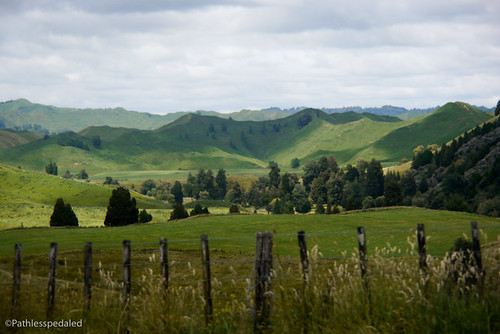

In doing our research beforehand, we knew that the only camp spot for the day was at least 80km down the very hilly road (unless we stumbled onto something else or opted to free camp), so we were up and on the road early that morning. We rolled through town, turned onto the Forgotten World Highway, and immediately spun our way up the first hill. From Taumarunui to just south of Whangamomona, the Forgotten World Cycle Trail follows an already-established tourist road known as the Forgotten World Highway. The highway is narrow, with no shoulders, but there is virtually no traffic. And, because the area is so quiet and rural, you can hear any cars well in advance. Over the course of the day, we went up, then down, then up, then down, over and over again, through rural farmland and bright green hillsides. The hills through this stretch of New Zealand, however, aren’t cute, coast-able bumps – they’re more like steep, mini-mountains that you slowly have to summit. We would huff and puff our way up, complaining and whining, and then we would get to the top and look out over the stunning scenery and just stand in awe of the landscape around us. Talking to the hundreds of sheep and cows that we passed helped take the edge off the climbing too. As the afternoon wore on, it felt like progress was very slow, which was compounded by the fact that none of the road signs had correct mileage information. And, then, we rounded a corner and found ourselves in the jungle. The Forgotten World Highway passes through Tangarakau Gorge, an incredible area full of thick native bush and jagged cliffs, showing off what New Zealand must have looked like everywhere before it was colonized. The road through the gorge is a hard-packed gravel, and we were delighted that the Bromptons handled the ride beautifully. On the other side, we found ourselves back in a landscape of steep, green pastures. We slogged our way up one last hill, exhausted and long ready to be done for the day, and turned off at Back Country Accommodation. After checking in, we pitched our tent in the open grass field, and looked out in awe of our nearly 360-degree view of endless green hills. We were literally on top of the world, and couldn’t believe our luck. That night, we went to sleep before the sun, listening to the sounds of the bleating sheep in the hills and the Tui birds playing in the flax bushes.



When we woke up the next morning, we were rather exhausted and sluggish. Everything was wet from a bit of rain overnight and we were happy to pack up slowly and wait for our clothes and tent to dry out. We thanked the folks at Back Country and rolled down the hill to Whangamomona. Signs greeted us as we entered ‘The Republic’ and we stopped at the hotel/pub for a second breakfast and a few more cups of coffee. By the time we headed back along our way, it was nearly noon, but we knew we had a shorter day ahead of us and could take our sweet time. We rambled up and over a few more bright green hills before reaching our turn off the highway. From here, we would follow posted NZ Cycle Trail signs, with arrows pointing us in the correct direction. At the turn-off, the road turns to gravel. It’s a looser, more slippery gravel than we encountered the day before, but completely rideable with wide tires and some patience. The scenery through this stretch is simply stunning (so far, we have yet to get tired of the bright green hills here), and the ride was made even more amazing by the fact that it is so rural, with no traffic and very little sign of people. We truly felt like we were in a forgotten world at this point. As we rolled down the road, we chatted with the cows and sheep, and eventually we arrived in what remains of the small community of Purangi. It’s just one couple now, Laurel and Ian, who own the schoolhouse and a walnut orchard. Through a stroke of fate, they met the man who routed the cycle trail, and they decided to open their property to passing cyclists. You can camp on the lawn or stay inside the schoolhouse (which is outfitted with beds and a kitchenette). They told us the history of the area and invited us in for tea. After Bridget and John and their kids arrived later that afternoon, the eight if us decided to pool our meals into a communal dinner and we all spent the evening laughing and swapping stories. It was a truly magical evening that ended only as the last bit of light was fading from the sky and the wine was putting was putting us all to sleep.
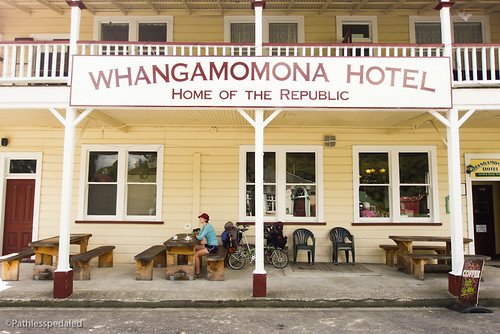

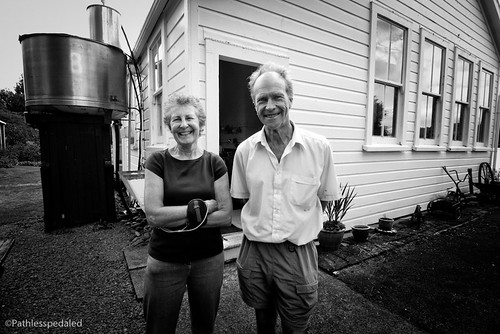
We rolled out of Purangi the next morning after some last conversation and photos. After seeing Bridget and John for the past several nights, we would be going our separate ways that day, so we wished each other well. We thanked Laurel and Ian for opening up their space for cyclists and we hope that it continues to be a worthwhile experience for them. Riding away from Purangi, we rambled up and over several more hills, through more gorgeously rural scenery and one narrow old tunnel, and then we turned a corner and stopped at the sight of Mt Taranaki peaking out of the clouds. As we began to roll into the outskirts of the New Plymouth area, the cycle trail begins to zig-zag through small farm roads. It was fantastic to not have to plan our way into the city and it’s evident that care was taken to choose quiet roads, but we had to be careful to not miss the small way-finding signs at each turn. Eventually, the cycle trail to leads to a series of multi-use paths. The Coastal Walkway path follows the Tasman Sea coastline into New Plymouth and is dotted with look-outs, public art, coffee carts, and one incredible bike-ped bridge. It was an amazing way to be welcomed into New Plymouth, which we hear is working to be a model cycling city. Coming in to a city again was a bit of a shock after the quiet of the countryside, but we were delighted with New Plymouth and looking forward to some good food and a mattress for the night.
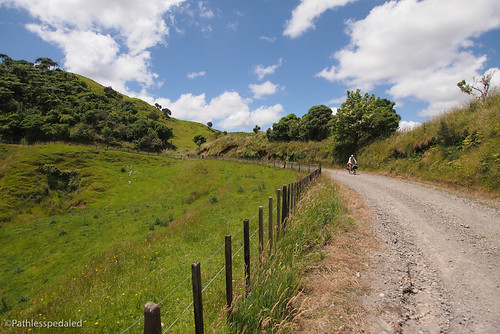
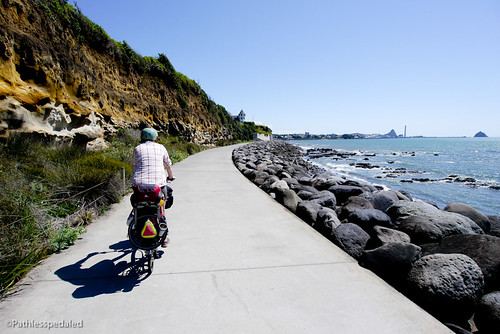
Overall, I would dare to say that the Forgotten World Cycle Trail was one of the most rewarding stretches of road that we’ve ridden. The scenery seriously out-does itself, the people we met were friendly and helpful – and it was an immense sense of achievement to complete the ride, because it was one of the most difficult stretches of road that we’ve ridden. In 180km, there are no markets, and the only place to buy food is at the pub in Whangamomona. Planning ahead is absolutely essential. The landscape will take your breath away and turn your legs into jello as you climb and climb and climb, so this is certainly not a beginner’s route. Our hope is that, over time, additional facilities will open up for cyclists along the way (a few other campgrounds, perhaps, and a cafe or two), because the low traffic volume and quiet, old-world charm make this an excellent route for capable cyclists looking for a rewarding rural adventure.
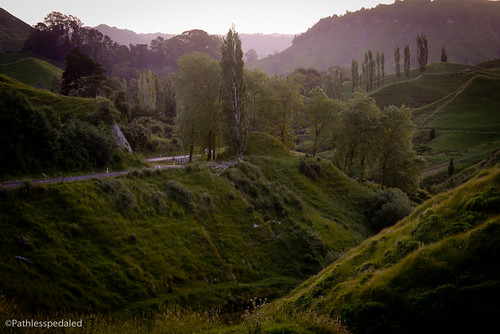

(Keep our adventures going and the site growing! If you’ve enjoyed our stories, videos and photos over the years, consider buying our ebook Panniers and Peanut Butter, or our new 2012 calendar or some of the fun zombie apocalypse shirts we’re designing.)
14 Comments
Leave a Reply to Paul
This site uses Akismet to reduce spam. Learn how your comment data is processed.
Subscribe
Patreon
Join Team Supple on Patreon
PayPal

Photos are gorgeous! which camera are you using? Can’t wait to see a new video of the route! Happy Traveling!
Amazing report – thanks a million, it captures my euphoria after doing the ride a year or so ago! I’m so glad you enjoyed the rural serenity and stunning panoramas too. Those ‘saddles’on the road ARE formidable, but I agree, they are worth it. Whangamomoma is a historic gem, and fabulous place to stay overnight in comfy beds.And the old schoolroom sounds like a welcome addition!Thanks again for a brilliant report!
Did you get a chance to pick up a Whangamomona republic passport?
Wow! Absolutely stunning. So green and lush. Not that NoHo isn’t… well, okay, no comparison. Thanks for sharing.
I’ve always looked at having a ride through the Forgotten Highway – just haven’t got around to it yet.
Looks like an amazing ride 😀
Here are pictures from my tour of the South Island:
https://picasaweb.google.com/106377638021655393024/NewZealandSouthIsland
Have you heard of Louise Sutherland? She was a Kiwi who did a solo around-the-world cycle tour in her 20s. Later, in her 50s, she became the first person to cycle the Trans-Amazon Highway.
OMG! Thank you for this. I am so enjoying imagining my own trip someday of the towns & scenery you are so eloquently describing! Happy pedaling!
your bicycling adventure really make you guys so lovely and it shows in your picture that it makes your bond stronger. Awesome adventure!
More pedal power to you both!
Your photos are incredible! I know you are using Nikon, but which model? What specific lens or lenses are you using for the above photos? I read all your posts everyday and keeps me motivated to keep riding my bike to work every day. Even in the freezing NY winter! Thank you for keeping us updated in your adventures!
Its one of the many truly wonderful rides/drives/walks NZ has to offer.
Sorry to read of your experiences in Wellington though – but most kiwis are actually pretty friendly people. Every country has idiots like that, unfortunately you met one of ours.
Other rides of note, should you have the time and be nearby, would be the Wanganui river road – its a rugged bit of countryside, but has a lot of history about it. Also, the Gentle annie, as its commonly known. This road links the Hawkes Bay with Taihape. http://www.nzherald.co.nz/city-breaks/news/article.cfm?c_id=633&objectid=10388194
The South island has a lot too..
Hope the rest of your time here in NZ is not as wet, and you happen across the people who make us proud to be Kiwis, not arseholes!.
Wow – a beautiful ride from the looks. Where is that lovely seaside concrete path? Somewhere leading into New Plymouth? So sorry to hear about the road-rage attack. Us Kiwis get too hot under the collar sometimes; there’s no excuse. I hope you thoroughly enjoy your wonderful cycling adventure around this beautiful country… 🙂
The Forgotten World Highway is on my list of rides to do when I return to NZ. Really inspired me on an other wise boring day at work. Loved your report on Waiheke Island. I caught the 360 Ferry to the far end of the island and rode back to the Fullers Ferry landing. There was a Tsunami warning out the day I was there but no one left the beach!
Wow – I loved your pics! I grew up in New Plymouth an have lived in Australia for the past 5 years but miss the beautiful small city every day!! Enjoy your travels guys!
sorry to read about your road rage attack!! what a shocker. i thoroughly enjoyed your writings and photos of the forgotten highway, hope to do it within 2 years and your blog has valuable tips.
i can recommend the otago rail trail if your headed that way also the ride from bannockburn to clyde is well worth it.
safe cycling, kia kaha